A rediscovered family heirloom is allowing Canadians to peer back in time through the lens of an 8mm camera.

For Mark Holtze, a Toronto-based vlogger, the look into the past began when he dug through his parents’ basement.
The death of his grandmother, his last living grandparent, inspired him to take a look the old family films that his parents had kept lying around.
“They were all unlabeled, with some only saying Vancouver 1964 or PEI and New Brunswick of the same year,” Holtze said. “I was expecting to see family reels, my grandpa or maybe when he was younger or my dad, and I have that stuff, but finding the location specific stuff has some value to the greater audience.”
READ MORE: ‘Trump Bump’ rolls along in Cape Breton
What Holtze discovered are the memories of a cross-country road trip taken by his great-grandparents.
Captured between 1964 and 1967 his great-grandparents documented where they went and what they saw with a particular for the landscape around them.
In Nova Scotia, the reels capture a glimpse of Peggy’s Cove, Cape Breton’s Cabot Trail and a group of fishermen as they process a whale by hand.
In New Brunswick, the old 8mm camera takes a look at the Mactaquac Dam as it was under construction, Magnetic Hill and the Hartland Bridge.
“It’s cool to see how things were, rather than how things are now,” said Holtze.
“These just feel very intimate, it’s not some big event that everyone remembers, it’s how you would remember your own life.”
READ MORE: N.B. modeller honours Canadian soldiers who fought at Vimy Ridge
It’s why Holtze has decided to share the series of videos on his YouTube channel. Each video captures a different province or region and Holtze says even though the videos are family memories, they should have value to all Canadians.
“These things kind of represent general life, how it was then versus how it was now,” he said.
- Life in the forest: How Stanley Park’s longest resident survived a changing landscape
- ‘Love at first sight’: Snow leopard at Toronto Zoo pregnant for 1st time
- Carbon rebate labelling in bank deposits fuelling confusion, minister says
- Buzz kill? Gen Z less interested in coffee than older Canadians, survey shows




Comments